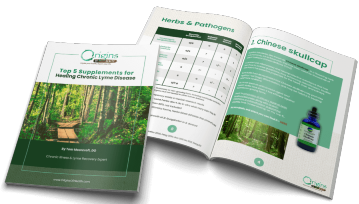Each year, hundreds of thousands of people are bitten by ticks—many of them never realizing the serious infections these tiny pests can transmit. Lyme disease, Babesia, Bartonella, and other co-infections are on the rise across the U.S., not just in the Northeast. A single tick bite can lead to weeks, months, or even years of health issues if not properly addressed.
As a physician who’s spent over 15 years treating Lyme and complex chronic illness, I’ve seen firsthand the difference early intervention makes. This post walks you through exactly what to do—from prevention to post-bite care—to reduce your risk and protect your health.
Tick Bite Prevention: Your First Line of Defense
Ticks don’t fly or jump. They cling to shoes, socks, and clothing as you brush past grass or leaf litter—often starting at ground level. That’s why strategic prevention works.
1. Use Permethrin-Treated Clothing (Especially Socks and Shoes)
One of the most effective methods we have is wearing permethrin-treated socks and shoes.
A 2011 controlled trial by the University of Rhode Island found that: Participants wearing permethrin-treated sneakers and socks were 73.6 times less likely to get a tick bite compared to those in untreated footwear. (Miller et al., 2011)
Larger field studies and randomized-controlled trials have confirmed the benefit. One landmark trial found:
- Long-lasting permethrin-impregnated uniforms reduced tick bites by 80% over a full season compared to untreated uniforms (Vaughn et al., 2014)
- 80–93% fewer tick bites among outdoor workers using factory-treated clothing
- Up to 99% protection during working hours
These results have been replicated in multiple settings, leading the CDC to recommend permethrin-treated clothing—including socks and shoes—as part of their personal tick protection guidelines.
Permethrin-treated items like those from Insect Shield® remain effective through up to 70 washes. You can either buy factory-treated clothing or treat your own with consumer permethrin sprays (just follow all safety instructions).
Target high-risk items:
- Socks
- Shoes
- Pant cuffs
- Waistbands
- Sleeves
2. Stick to the Middle of Trails
Ticks wait at the edges of trails or tall grasses for a host to pass by. Avoid brushing against vegetation whenever possible.
3. Dress Defensively
Wear long sleeves and pants, ideally in light colors so ticks are easier to spot. Tuck pants into socks and shirts into pants to reduce exposed entry points. Super cool, I know, but preventing tick bites and subsequent Lyme disease is definitely worth it!
One trick I use is wearing tight fitting boxer short type underwear. These are quite functional for outdoor activities and create an occlusive barrier between your warm, dark, moist nether regions and ticks. These areas are preferred areas to ticks to bite and attach – putting up a physical barrier – preferably treated with permethrin – can dramatically reduce risk of a hidden tick bite.
4. Use Safe, Effective Repellents
While DEET can work (yes, it is toxic and will melt plastic bandaids; and doesn’t work that well for ticks to begin with), many patients (and me!) prefer non-toxic botanical options like:
- Lemon eucalyptus (Gardulf et al 2004)
- Rose geranium oil
- Cedarwood
- Lavender or clove
In 2008, Pålsson et al found certain essential oils to be very effective in repelling ticks by up to 64-72%.
Apply repellents every 2–3 hours—especially after sweating or swimming.
5. Check Early and Often
Do full-body tick checks during and after your outdoor activities, especially:
- Behind ears
- Along the hairline
- Underarms
- Waistband and groin
- Behind knees
- Ankles and feet
6. Shower and Heat-Dry Clothes
- Shower as soon as possible when returning indoors
- Tumble dry clothes on high heat for 30–60 minutes to kill any lingering ticks
7. Don’t Forget Pets or Gear
Ticks can hitch a ride home on dogs, backpacks, or firewood. Always check pets, gear, and camping equipment.
What If You Find a Tick Attached?
- Don’t Panic. Not every tick transmits disease. What matters most is what you do next.
- Remove the Tick Safely.
- Use fine-tipped tweezers to grasp the tick close to the skin
- Pull upward with steady pressure—don’t twist or squeeze—you may need to wait 30-60 seconds, or even a couple of minutes, for the tick to release. DON’T rush – just lift and hold. This will work and is the SAFEST method to remove a tick
- Clean the area with soap and water or antiseptic
- Save the Tick for Testing.
- Place in a sealed bag with a damp cotton ball
- Send to a lab like TickReport, TickCheck or Ticknology
- Mark the Bite Site.
- Draw a circle with a pen to monitor changes
Should You Take Antibiotics?
If you’re bitten by a black-legged or deer tick (Ixodes scapularis) or western black-legged tick (Ixodes pacificus) speak with your licensed healthcare provider and consider prophylactic treatment to help prevent Lyme disease:
- Doxycycline, Amoxicillin, or Azithromycin for 21–28 days.
- One dose of any antibiotic has NOT be shown to decrease the risk of Lyme disease and it may actually blunt your antibody response and prevent the Lyme rash WITHOUT actually preventing Lyme disease – which means our 2 most important Lyme markers may become negative EVEN when you have Lyme.
- Many great, though not well studied, herbal options also exist, so speak with your licensed healthcare provider for guidance.
Note: Short-term doxycycline is now considered safe for children under 8, per CDC and AAP guidance.
Support Your Gut During Treatment
To prevent microbiome disruption:
- Probiotics (2 hours after antimicrobials)
- Fermented foods like sauerkraut, kimchi, kefir
- Bone broth and collagen
Know the Symptoms of Lyme
Early (3–30 days):
- Flu-like illness (fever, chills, muscle aches)
- Fatigue
- Headache
- Neck stiffness
- Joint or muscle pain
- Swollen lymph nodes
- Skin rash: about 50% of patients will develop an erythema migrans (EM) rash. Of those who do get a rash, only about 30% show the classic “bull’s-eye” appearance. So don’t rely on a bull’s-eye to confirm Lyme.
Later (weeks to months):
- Migratory joint pain and inflammation, particularly in knees or large joints
- Bell’s palsy (facial paralysis)
- Neuropathy (numbness, tingling, or burning in extremities)
- Cognitive dysfunction/brain fog (“Lyme brain”): memory loss, difficulty concentrating
- Mood changes: anxiety, depression, irritability
- Severe fatigue
- Sleep disturbances
- Dizziness or fainting
- Heart symptoms: palpitations, heart block
- Sensitivity to light and sound
- Gastrointestinal complaints
- New onset of behavioral issues in children (e.g., tics, rage, OCD)
- Visual or auditory disturbances
Don’t Rely Solely on Standard Lyme Tests
- Ask for a full IgM/IgG immunoblot
- IGeneX offers FDA-cleared immunoblots that test not only for Borrelia burgdorferi, but for all known Borrelia species and strains that can cause Lyme disease—not just the limited strains included in standard testing panels
- Much of the dogma about interpreting Lyme testing has been shown to be quite outdated. Work out of Johns Hopkins has shown the seroconversion to IgG is uncommon, which goes in the face of the prevailing dogma.
- The long standing CDC criteria for diagnosing Lyme has also recently changed when IGenex let the science lead the way and showed their testing methodology, including using less, but more Lyme specific band on blot tests led to IMPROVED diagnostics accuracy. So the old criteria has been scientifically validated to be old and outdated. Practitioners – STOP using this. If you continue to use the old criteria, you’re likely missing Lyme frequently and patients are suffering needlessly because of it.
- Clinical diagnosis is key—even the CDC acknowledges testing limitations
Final Thoughts
Early, proactive care makes all the difference. Know how to prevent bites, respond effectively, and recognize symptoms. With the right action, most tick bites don’t have to lead to Lyme.
References:
- Miller NJ et al. Tick bite protection with permethrin-treated summer-weight clothing. J Med Entomol. 2011;48(2):327–333. doi:10.1603/me10158
- Vaughn MF, Funkhouser SW, Lin FC, et al. Long-lasting permethrin impregnated uniforms: A randomized-controlled trial for tick bite prevention. Am J Prev Med. 2014;46(5):473–480. doi:10.1016/j.amepre.2014.01.008
- Rebman AW, Crowder LA, Kirkpatrick A, Aucott JN. Characteristics of seroconversion and implications for diagnosis of post-treatment Lyme disease syndrome: acute and convalescent serology among a prospective cohort of early Lyme disease patients. Clin Rheumatol. 2015;34(3):585–589. doi:10.1007/s10067-014-2842-0
- Aucott JN, Rebman AW, Crowder LA, Kortte KB. Post-treatment Lyme disease syndrome symptomatology and the impact on life functioning: is there something here? Qual Life Res. 2013;22(1):75–84. doi:10.1016/j.arthro.2014.03.015
- U.S. Food and Drug Administration. IGeneX ImmunoBlot FDA Clearance. https://www.accessdata.fda.gov/cdrh_docs/pdf21/K213823.pdf
- Centers for Disease Control and Prevention. Preventing tick bites. https://www.cdc.gov/ticks/avoid/on_people.html
- Gardulf A, Wohlfart I, Gustafson R. A prospective cross-over field trial shows protection of lemon eucalyptus extract against tick bites. J Med Entomol. 2004;41(6):1064-1067. doi:10.1603/0022-2585-41.6.1064
- Pålsson K, Jaenson TG, Baeckström P, Borg-Karlson AK. Tick repellent substances in the essential oil of Tanacetum vulgare. J Med Entomol. 2008;45(1):88-93. doi:10.1603/0022-2585(2008)45[88:TRSITE]2.0.CO;2
- https://www.cdc.gov/rocky-mountain-spotted-fever/hcp/data-research/index.html


